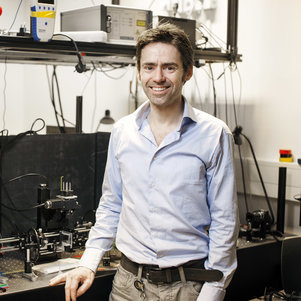Researchers peer deep inside tissue
One of the challenges in optical imaging is to visualize the inside of tissue in high resolution. Traditional methods allow us to look to a depth of approximately one millimetre. Researchers at Delft University of Technology have now developed a new method that can penetrate up to four times as deep: up to around four millimetres. The healthcare sector in particular may benefit from the new technique in the future.
The new imaging method brings together a number of existing techniques. The most important of these is Optical Coherence Tomography (OCT), a technique ophthalmologists use to image the retina. OCT is similar to acoustic ultrasound, but uses light instead of sound waves while having a higher resolution. Using the information contained in the reflected light waves, an algorithm can create a cross section of the tissue.
Cross section
Unlike a normal OCT scan, the Delft researchers do not make images with reflected light, but send the light right through the tissue. On the other side, a sensor captures it again. The researchers can see which light arrives and when. "The light that travels for a longer period of time is scattered through the tissue and arrives at the detector relatively late," TU Delft researcher Jeroen Kalkman explains. "Usually this causes the resulting images to be blurred. But by looking at the arrival time, we can separate this scattered light from the light that went straight through the sample. With the light that arrives early, we can produce a sharp image."
In order to make a cross-section, a so-called tomogram, of the object, the researchers use technologies known from computer tomography, of which the best-known example is the CT scan. "This involves measuring a projection of the X-rays coming through the object at many different angles and positions," says Kalkman. "You can then connect all these different projections together using a computer to create a three-dimensional image. We do the same thing, but with light."
Huge thrill
To find out how powerful their technique is, the researchers tested it on dead zebrafish, which they obtained through an ongoing study at Erasmus MC. The maximum penetration depth was found to be about four millimetres, an improvement of a factor of four compared to the current reflection approach in OCT. In addition, the various zebrafish organs could be depicted with high contrast by looking at both the strength and the arrival time of the light. Kalkman: "We've been working on this with a whole team of researchers for almost ten years, so it's a huge thrill that we've finally got it done."
In the future, the new Delft technique could generate valuable information about certain diseases. "With our method, we would be able to follow the development of such a disease very precisely over time," says Kalkman. "That way, we could study the effects of medicines or, conversely, potentially toxic substances on tissue. Doing so could provide us with useful insights that can ultimately lead to better treatments or better protection."
Another application of the new method is the analysis of biopsies, small pieces of human tissue that doctors take from patients for analysis. "Currently, labs often add fluorescent labels to biopsies, or they cut them into small slices and use optical clearing to make them more transparent," says Kalkman. "This takes a long time, and during this process biopsies can deform. We expect our technique to be able to image the biopsies in their three-dimensional form, thus helping doctors make a more accurate diagnosis."
More information
‘Deep-tissue label-free quantitative optical tomography’, Jelle van der Horst, Anna K. Trull, Jeroen Kalkman, Optica
Article